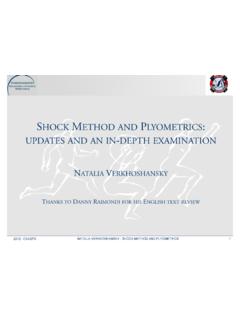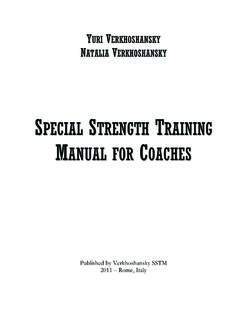Transcription of Shock Method and Plyometrics - Verkhoshansky
1 SHOCKMETHOD ANDPLYOMETRICS: UPDATES AND AN IN-DEPTH EXAMINATIONNATALIAVERKHOSHANSKYTHANKS TODANNYRAIMONDI FOR HISENGLISH TEXT REVIEW2012 - CVASPS1 NATALIA Verkhoshansky - Shock Method AND PLYOMETRICSTABLE OFCONTENT1. FROM DEPTH JUMPS TO THE Shock FROM THE Shock Method TO PLYOMETRICS1 3 THE PROBLEMS WHEN USING THE PROBLEMS WHEN USING Plyometrics 2. IN-DEPTH EXAMINATION OF Shock KINETIC ENERGY OF FALLING WEIGHT AS A MUSCLE STIMULATING THE MASS OF FALLING WEIGHT AND THE HEIGHT FROM WHICH IT THE ESSENCE OF THE Shock METHOD3IN-DEPTH EXAMINATION OF PLYOMETRICS3. IN-DEPTH EXAMINATION OF TERMINOLOGICAL MIOGENIC AND NEUROGENIC FACTORS IN NEUROGENIC FACTORS - LATER THE Shock Method AS A PARTICULAR FORM OF PLYOMETRICS4. KEY POINTS TO SUCCESSFULLY USING PLYOMETRICS4 1 TAXONOMY OF PLYOMETRIC TAXONOMY OF PLYOMETRIC PLYOMETRIC EXERCISES EMPHASIZING ELASTIC ENERGY PLYOMETRIC EXERCISES EMPHASIZING POTENTIATION OF THE STRETCH PLYOMETRIC EXERCISES EMPHASIZING THE CNS STIMULATION4 5 USING THE DEPTH JUMP ACCORDING TO Y USING THE DEPTH JUMP ACCORDING TO PROGRESSING THE PLYOMETRIC EXERCISES DURING THE PREPARATION PERIOD2012 - CVASPS2 NATALIAVERKHOSHANSKY- Shock Method AND PLYOMETRICS1.
2 FROMDEPTHJUMPS TO THESHOCKMETHODAt the end of the 1950s, Yuri Verkhoshansky , asuccessful coach of the Track & Field jumpers, andstudents from the Aeronautical Engineering Institute,created a new training mean vertical drop-reboundjump (Depth Jump). This exercise helped his athletesobtain an unexpectedly high increase in the level ofspecificperformance:twelveofthemobtain edthetitlespecificperformance:twelveofth emobtainedthetitle Master of Sport .kh hk hk hb h h dh f hdVerkhoshansky then took the opportunity to be the head coach of the Moscow United Te a m in the sprinting and jumping events. In 1964, his athlete Boris Zubov became both the European and Soviet record holder in the sprint events. Y. Verkhoshansky entered in the coaches staff of the soviet national track-and-field staff of the soviet national trackandfield years later, Verkhoshansky would discontinue his coaching career and concentrate his work on scientific research.
3 In his research, the use falling weight's kinetic energy to increase the strength effort was adapted further for upper body explosive movements. gpppypVerkhoshansky named this discovery the The Shock Method (1968)2012 - CVASPS3 NATALIAVERKHOSHANSKY- Shock Method AND PLYOMETRICS1. FROMDEPTHJUMPS TO THESHOCKMETHOD1959 article New Method of the strength preparation of jumpers (the bulletin Collection of scientific works of the Central researches institute of physical culture , 2328)page 23-28)1961 book Triple Jump . Moscow. Fiskultura i Sport1964 article Novelty in the strength preparation of jumpers (Track and Field Magazine, n 7).1967 article Are the Depth Jumps useful? (Track and Field Magazine, n 12)1966 article The dynamic structure of complex motor actions (Theory and Practice of Physical Culture, )1968 article The Shock - Method of the development of explosive strength (Theory and Practice of Physical Culture, )1979 article Some particularities of the human working movements (Theory and Practice of Physical Culture, ).
4 1986 article The influence of Shock Method on the electro-miographic parameters of maximal explosive effort (Theory and Practice of Physical Culture, , with , , )).2012 - CVASPS4 NATALIA Verkhoshansky - Shock Method AND PLYOMETRICS1. FROMDEPTHJUMPS TO THESHOCKMETHODSome of Verkhoshansky s articles were translated by Dr. and published in the USADr. Michael Yessis,a professor emeritus in biomechanics and kinesiology and president of Sports Training the foremost expert on Russian training methods has translated and published Russian training articles in the Fitness andmethods, has translated and published Russian training articles in the Fitness and Sports Review International for over 29 years. Having earned a at the University of Southern California , he travelled to Russia to meet Dr. Yuri Verkoshansky and to learn the training techniques from the masters -Perspectives in the improvement of speed-strength 1968 -Are depth jumps useful?
5 ,Soviet sport review, , of jumpers, Soviet sport review, , jump in the training of jumpers, Track pj pg j p,Tecnique, , - CVASPS5 NATALIA Verkhoshansky - Shock Method AND PLYOMETRICS1. FROM THESHOCKMETHOD TOPLYOMETRICSFred Wilt popularised jump training used by Eastern Bloc coaches in the USA, pioneering the term Plyometrics . Fred Wilt(1920 1994) was a distance runner in the Wilt was a member of the 1948 and 1952 Ol mpic teams and famo s fo his legenda indoo milethe 1948 and 1952 Olympic teams, and famous for his legendary indoor mile encounters at that time with Wisconsin's Don Gehrmann. After retiring from the FBI, Wilt coached the women's running teams at Purdue University. He edited the publication Track Technique and advised various athletes. His star pupil was 1964 Olympian Buddy Edelen who held the world marathon record of 2:14:28 In theOlympian Buddy Edelen, who held the world marathon record of 2:14:28.
6 In the 1960s and 1970s, Fred Wilt became a famous writer and advocate of running. His book, How They Train , was a long-time best seller. His most popular book "Run, Run, " is an incredible collection of articles on science, history, and methods of running reflecting his passion and desire to bring real knowledge to peoplerunning, reflecting his passion and desire to bring real knowledge to Wilt. From the Desk of Fred Wilt: Plyometric Exercises. Track Technique. 64:2024-2054. 1978-Fred Wilt. Plyometrics What is it and how it works, Modern athlete and coach, , - CVASPS6 NATALIA Verkhoshansky - Shock Method AND PLYOMETRICS1. FROM THESHOCKMETHOD TOPLYOMETRICSFred Wilt interpreted Plyometrics as exercises that produce "an overload of isometric-type muscle action which invokes the stretch reflex in muscle"muscleNATALIA Verkhoshansky - Shock Method AND PLYOMETRICS2012 - CVASPS1. THE PROBLEMS WHEN USINGPLYOMETRICS2012 - CVASPS8 NATALIA Verkhoshansky - Shock Method AND PLYOMETRICS2.
7 IN-DEPTH EXAMINATION OF THESHOCKMETHOD21 KINETIC ENERGYOF FALLING WEIGHTASAMUSCLE STIMULATING THE MASS OF FALLING WEIGHT AND THE HEIGHT FROM WHICH IT THE ESSENCE OF THESHOCKMETHOD2012 - CVASPSNATALIAVERKHOSHANSKY- Shock Method AND PLYOMETRICS2. IN-DEPTH EXAMINATION OF KINETIC ENERGY OF FALLING WEIGHT AS A MUSCLE STIMULATING FACTORThe essential element of the Shock regime is sharp, compulsory muscular tension, initiated by the body s impact (collision*) with an external object. *Collisionis an isolated event in which two or more moving bodies (colliding bodies) exert forces on each other for a relatively short time. Collision could occur also berween the moving and unmoving bodies. An example is the foot with the underlying substrate forces during jumping and running: ground reaction forcesare generated during amortisation involve forces because there is a change in the velocity of the moving bodies All collisions conserve momentumWhatCollisions involve forces, because there is a change in the velocity of the moving bodies.
8 All collisions conserve momentum. What distinguishes different types of collisions is whether they also conserve kinetic energy(E = mv ). Collisions can either be elastic,meaning they conserve both momentum and kinetic energy, or inelastic, meaning they conserve momentum but not kinetic energy Elastic collision is defined as one in which there is no loss of kinetic energy in the collision. hHJumpFalling body weight (m)Fall height(h)ImpacthE = m hg E restitution Jump height(H)I = FtGround contact time(t)Amortization phasePushing phasecoefficient = h/HE conservingGround contact time(t)Is the higher force, expressed in the take-off movement of depth jumps, related only to the restitution of kinetic energy accumulated during the body s falling?ygygyg2012 - CVASPS10 NATALIA Verkhoshansky - Shock Method AND PLYOMETRICS2. IN-DEPTH EXAMINATION OF KINETIC ENERGY OF FALLING WEIGHT AS A MUSCLE STIMULATING FACTORThe first experiment of Verkhoshansky (1968):The athletes executed a maximal effort vertical jump from 3 different initial positions (functional state) of the working musclesFast shortening of the lidl hdSINGLE OVERCOMING MOVEMENTCOUPLING REVERSIBLE MOVEMENTFast shortening of the lldlFast shortening of the muscles, idlt t h d d imuscles, rapidly stretched under the body weight during the preceding countermovementisometrically contracted muscles, formerly lengthened and stretched under the weight of bodyrapidly stretched during amortisation phase under the sharp impact of the falling body s forceVertical jump without countermovementVertical jump with Vertical Jump after landing fromcountermovementVertical jump with countermovementVertical Jump after landing from a drop height of 50 cm( 20in.)
9 Isometric-miometric regimePliometric-miometric regime Shock regime2012 - CVASPS11 NATALIA Verkhoshansky - Shock Method AND PLYOMETRICS2. IN-DEPTH EXAMINATION OF KINETIC ENERGY OF FALLING WEIGHT AS A MUSCLE STIMULATING FACTORThe first experiment of Verkhoshansky (1968):The height of vertical jump (h2) was highest when the athlete performed it immediatelly after landingthe athlete performed it immediatelly after landing from a drop height of 50 cm (h1): the vertical jump height was higher than the drop height (coefficient of reactivityh2/ h1= ). Dinamogrammsof ground reaction force efforts:The height of vertical jump - H (cm)Dinamogrammsof ground reaction force efforts: active force in value of the body weight (P) and the time of force employment t (s).2012 - CVASPS12 NATALIA Verkhoshansky - Shock Method AND PLYOMETRICS2. IN-DEPTH EXAMINATION OF KINETIC ENERGY OF FALLING WEIGHT AS A MUSCLE STIMULATING FACTORThe second experiment of (1979)The athletes executed a maximal explosive force effort (pushing up a weight of 60% of maximal) in 4 different starting positions, which were characterised by different states (functional conditions) of muscles.
10 Voluntary dynamic countermovementIsometric tension equal to the weight Realx Involuntary repetnine tension provokrd by the impact with falling weightFast push-up of the bl k di ht ith tFast push-up of the non Fast push-up of the non Fast push-up of the falling ()SINGLE OVERCOMING MOVEMENTCOUPLING REVERSIBLE MOVEMENT blocked weight without counter-movementppblocked weight without counter-movementppblocked weight with counter-movementppgweight with counter-movementh= mMiometric regimeIsometric-miometric regimePliometric-miometric regime Shock regime2012 - CVASPS13 NATALIA Verkhoshansky - Shock Method AND PLYOMETRICS2. IN-DEPTH EXAMINATION OF KINETIC ENERGY OF FALLING WEIGHT AS MUSCLE STIMULATING FACTOR4- Shock regimeThe second experiment of (1979)3 - Pliometric-miometric regime4 Shock regime2 - Isometric-miometric regime1 - Miometric regimeConclusions: the power output of the loaded movement depends on the initial condition (functional state) of the working muscles: aThe curves of the weight acceleration during the pushing up of the weight equal state) of the working muscles: a greater muscle activation by an external load equates to greater power outputto the 60% of maximal executed in 4 different initial conditions (functional states) of muscles 2012 - CVASPS14 NATALIA Verkhoshansky - Shock Method AND PLYOMETRICS2.


